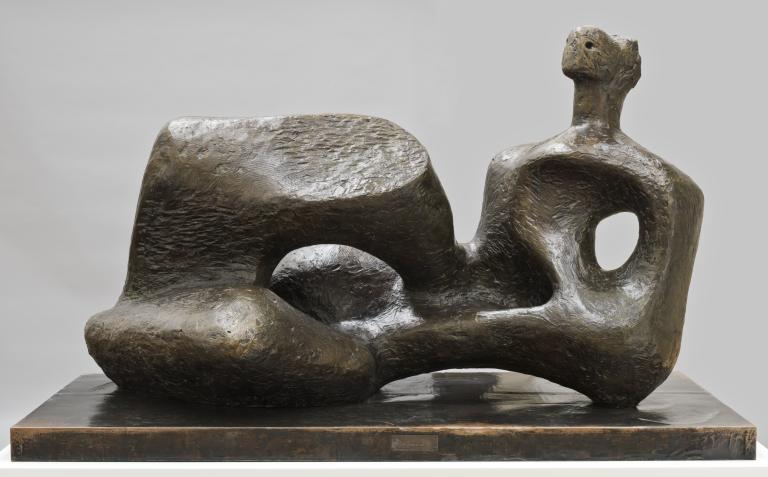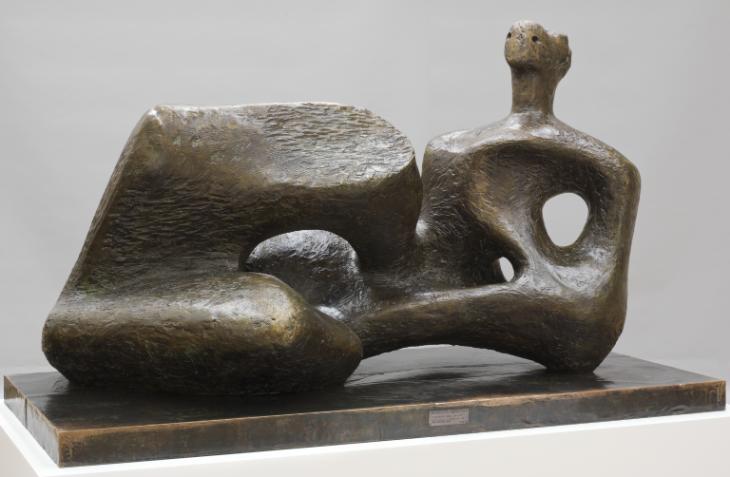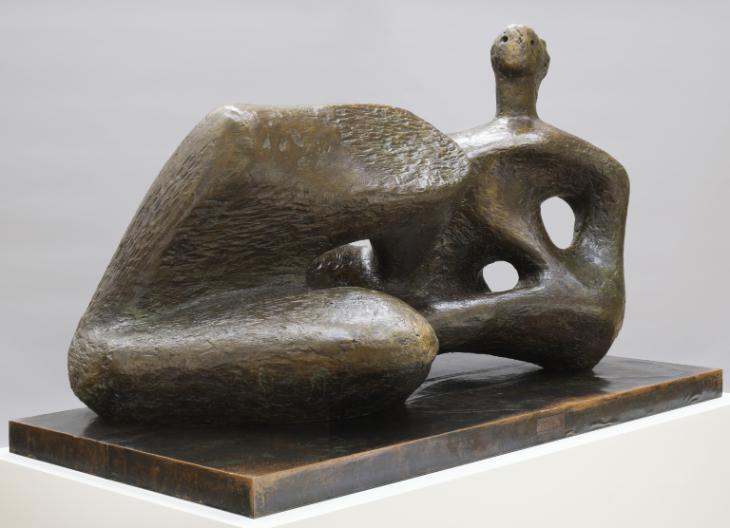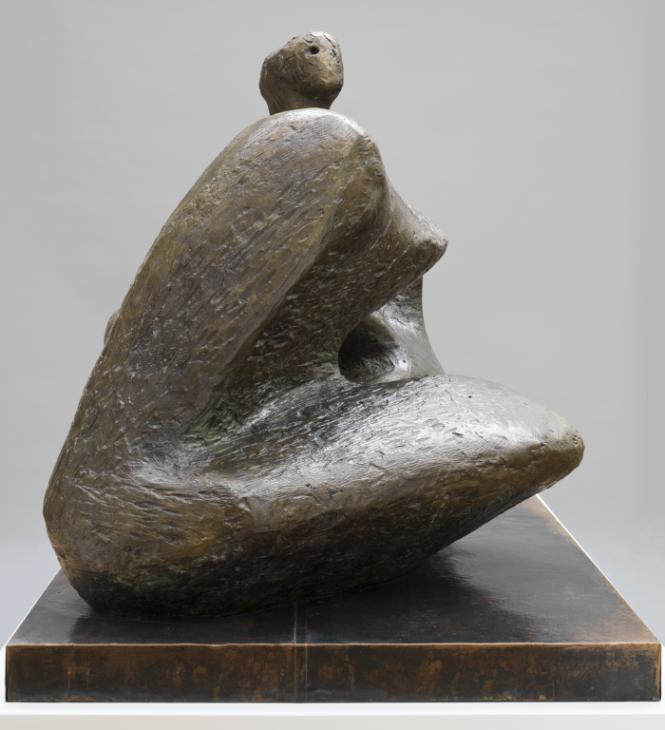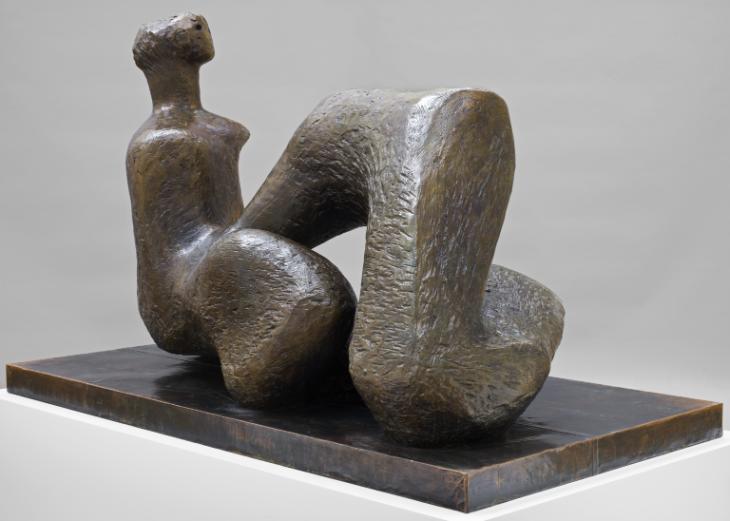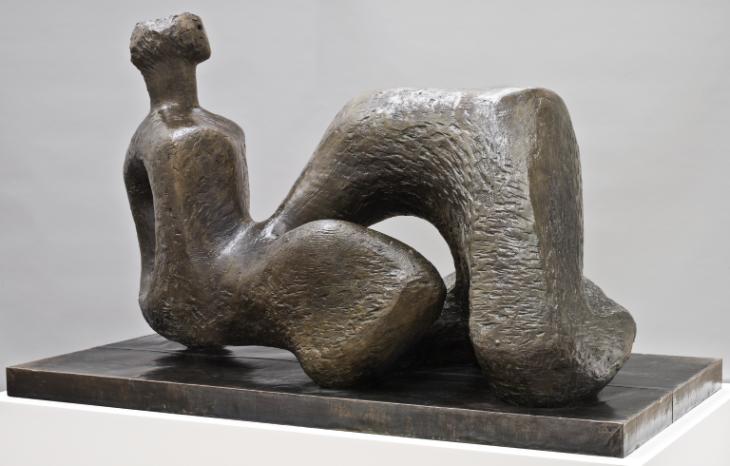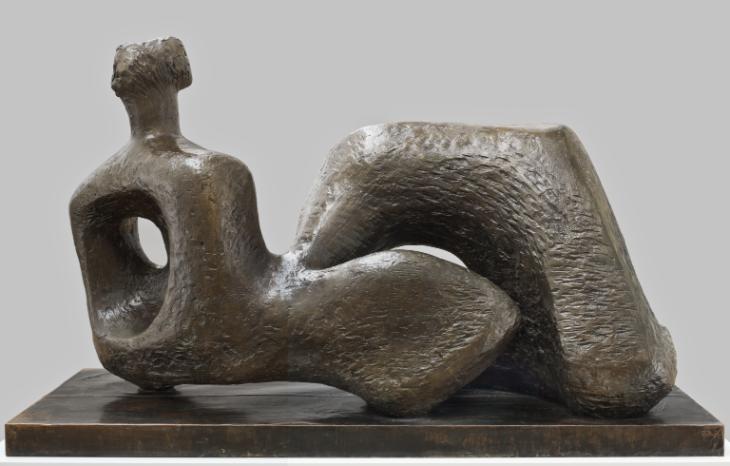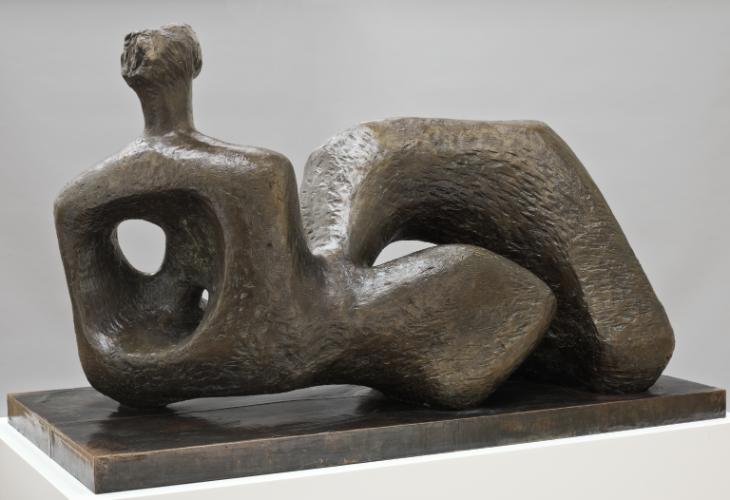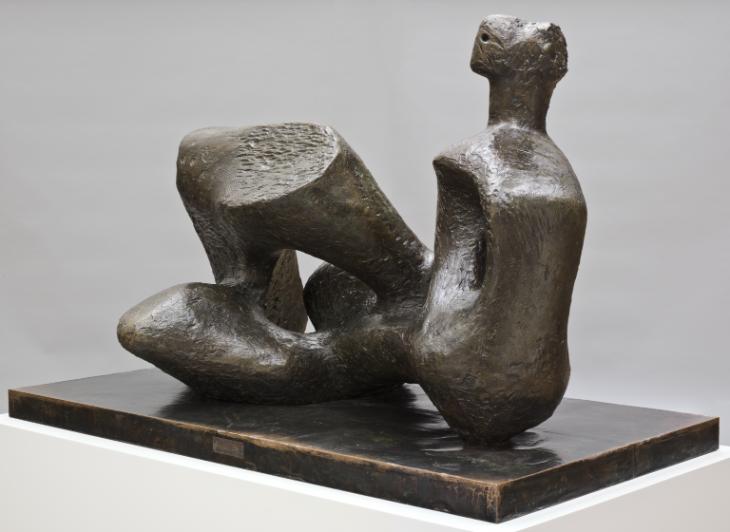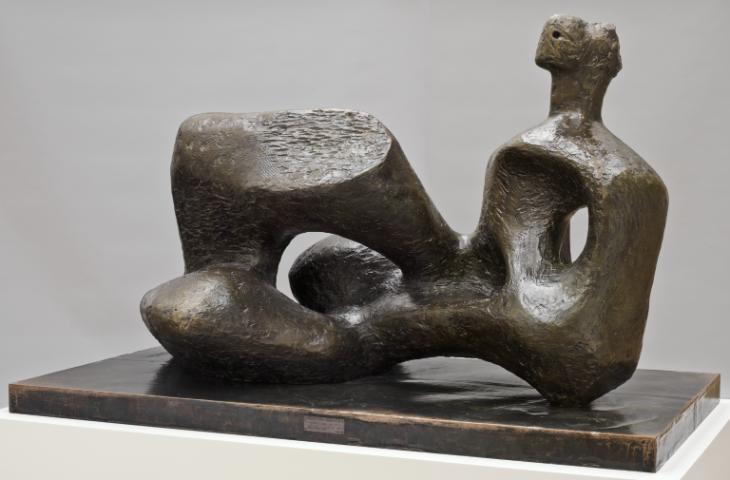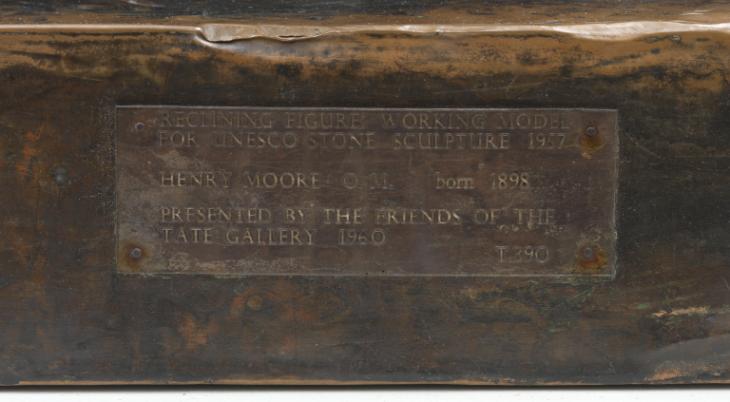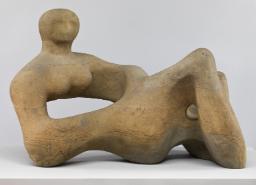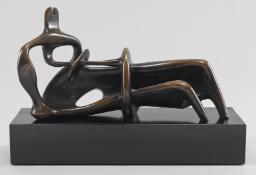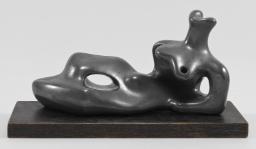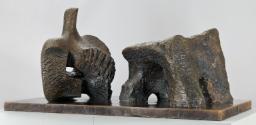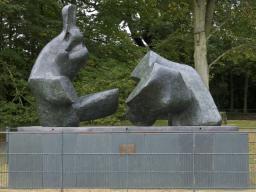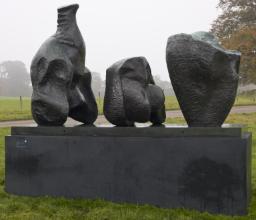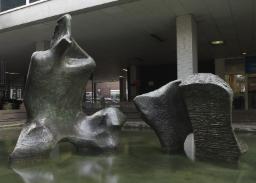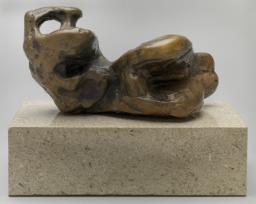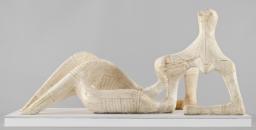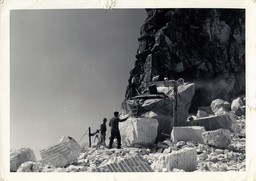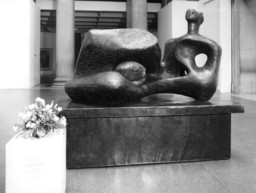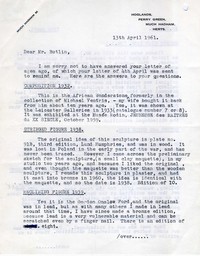Henry Moore OM, CH Working Model for Unesco Reclining Figure 1957, cast c.1959-61
Image 1 of 16
-
 Henry Moore OM, CH, Working Model for Unesco Reclining Figure 1957, cast c.1959-61© The Henry Moore Foundation. All Rights Reserved© The Henry Moore Foundation. All Rights Reserved
Henry Moore OM, CH, Working Model for Unesco Reclining Figure 1957, cast c.1959-61© The Henry Moore Foundation. All Rights Reserved© The Henry Moore Foundation. All Rights Reserved -
 Henry Moore OM, CH, Working Model for Unesco Reclining Figure 1957, cast c.1959-61© The Henry Moore Foundation. All Rights Reserved© The Henry Moore Foundation. All Rights Reserved
Henry Moore OM, CH, Working Model for Unesco Reclining Figure 1957, cast c.1959-61© The Henry Moore Foundation. All Rights Reserved© The Henry Moore Foundation. All Rights Reserved -
 Henry Moore OM, CH, Working Model for Unesco Reclining Figure 1957, cast c.1959-61© The Henry Moore Foundation. All Rights Reserved© The Henry Moore Foundation. All Rights Reserved
Henry Moore OM, CH, Working Model for Unesco Reclining Figure 1957, cast c.1959-61© The Henry Moore Foundation. All Rights Reserved© The Henry Moore Foundation. All Rights Reserved -
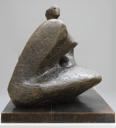 Henry Moore OM, CH, Working Model for Unesco Reclining Figure 1957, cast c.1959-61© The Henry Moore Foundation. All Rights Reserved© The Henry Moore Foundation. All Rights Reserved
Henry Moore OM, CH, Working Model for Unesco Reclining Figure 1957, cast c.1959-61© The Henry Moore Foundation. All Rights Reserved© The Henry Moore Foundation. All Rights Reserved -
 Henry Moore OM, CH, Working Model for Unesco Reclining Figure 1957, cast c.1959-61© The Henry Moore Foundation. All Rights Reserved© The Henry Moore Foundation. All Rights Reserved
Henry Moore OM, CH, Working Model for Unesco Reclining Figure 1957, cast c.1959-61© The Henry Moore Foundation. All Rights Reserved© The Henry Moore Foundation. All Rights Reserved -
 Henry Moore OM, CH, Working Model for Unesco Reclining Figure 1957, cast c.1959-61© The Henry Moore Foundation. All Rights Reserved© The Henry Moore Foundation. All Rights Reserved
Henry Moore OM, CH, Working Model for Unesco Reclining Figure 1957, cast c.1959-61© The Henry Moore Foundation. All Rights Reserved© The Henry Moore Foundation. All Rights Reserved -
 Henry Moore OM, CH, Working Model for Unesco Reclining Figure 1957, cast c.1959-61© The Henry Moore Foundation. All Rights Reserved© The Henry Moore Foundation. All Rights Reserved
Henry Moore OM, CH, Working Model for Unesco Reclining Figure 1957, cast c.1959-61© The Henry Moore Foundation. All Rights Reserved© The Henry Moore Foundation. All Rights Reserved -
 Henry Moore OM, CH, Working Model for Unesco Reclining Figure 1957, cast c.1959-61© The Henry Moore Foundation. All Rights Reserved© The Henry Moore Foundation. All Rights Reserved
Henry Moore OM, CH, Working Model for Unesco Reclining Figure 1957, cast c.1959-61© The Henry Moore Foundation. All Rights Reserved© The Henry Moore Foundation. All Rights Reserved -
 Henry Moore OM, CH, Working Model for Unesco Reclining Figure 1957, cast c.1959-61© The Henry Moore Foundation. All Rights Reserved© The Henry Moore Foundation. All Rights Reserved
Henry Moore OM, CH, Working Model for Unesco Reclining Figure 1957, cast c.1959-61© The Henry Moore Foundation. All Rights Reserved© The Henry Moore Foundation. All Rights Reserved -
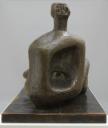 Henry Moore OM, CH, Working Model for Unesco Reclining Figure 1957, cast c.1959-61© The Henry Moore Foundation. All Rights Reserved© The Henry Moore Foundation. All Rights Reserved
Henry Moore OM, CH, Working Model for Unesco Reclining Figure 1957, cast c.1959-61© The Henry Moore Foundation. All Rights Reserved© The Henry Moore Foundation. All Rights Reserved -
 Henry Moore OM, CH, Working Model for Unesco Reclining Figure 1957, cast c.1959-61© The Henry Moore Foundation. All Rights Reserved© The Henry Moore Foundation. All Rights Reserved
Henry Moore OM, CH, Working Model for Unesco Reclining Figure 1957, cast c.1959-61© The Henry Moore Foundation. All Rights Reserved© The Henry Moore Foundation. All Rights Reserved -
 Henry Moore OM, CH, Working Model for Unesco Reclining Figure 1957, cast c.1959-61© The Henry Moore Foundation. All Rights Reserved© The Henry Moore Foundation. All Rights Reserved
Henry Moore OM, CH, Working Model for Unesco Reclining Figure 1957, cast c.1959-61© The Henry Moore Foundation. All Rights Reserved© The Henry Moore Foundation. All Rights Reserved -
 Henry Moore OM, CH, Working Model for Unesco Reclining Figure 1957, cast c.1959-61© The Henry Moore Foundation. All Rights Reserved© The Henry Moore Foundation. All Rights Reserved
Henry Moore OM, CH, Working Model for Unesco Reclining Figure 1957, cast c.1959-61© The Henry Moore Foundation. All Rights Reserved© The Henry Moore Foundation. All Rights Reserved -
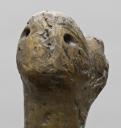 Henry Moore OM, CH, Working Model for Unesco Reclining Figure 1957, cast c.1959-61© The Henry Moore Foundation. All Rights Reserved© The Henry Moore Foundation. All Rights Reserved
Henry Moore OM, CH, Working Model for Unesco Reclining Figure 1957, cast c.1959-61© The Henry Moore Foundation. All Rights Reserved© The Henry Moore Foundation. All Rights Reserved -
 Henry Moore OM, CH, Working Model for Unesco Reclining Figure 1957, cast c.1959-61© The Henry Moore Foundation. All Rights Reserved© The Henry Moore Foundation. All Rights Reserved
Henry Moore OM, CH, Working Model for Unesco Reclining Figure 1957, cast c.1959-61© The Henry Moore Foundation. All Rights Reserved© The Henry Moore Foundation. All Rights Reserved -
 Henry Moore OM, CH, Working Model for Unesco Reclining Figure 1957, cast c.1959-61© The Henry Moore Foundation. All Rights Reserved© The Henry Moore Foundation. All Rights Reserved
Henry Moore OM, CH, Working Model for Unesco Reclining Figure 1957, cast c.1959-61© The Henry Moore Foundation. All Rights Reserved© The Henry Moore Foundation. All Rights Reserved
© The Henry Moore Foundation. All Rights Reserved
Henry Moore OM, CH,
Working Model for Unesco Reclining Figure
1957, cast c.1959-61
© The Henry Moore Foundation. All Rights Reserved
Working Model for Unesco Reclining Figure is a bronze version of the preparatory design for the monumental Unesco Reclining Figure, carved in marble in 1957–8. The sculpture presents a reclining female figure made up of hollowed forms, and has been interpreted as a symbolic mother figure, expressive of the regenerative aspirations of the post-war period.
Henry Moore OM, CH 1898–1986
Working Model for Unesco Reclining Figure
1957, cast c.1959–61
Bronze
1440 x 2440 x 1220 mm, 730 kg
Presented by the Friends of the Tate Gallery 1960
Number 2 in an edition of 7
T00390
Working Model for Unesco Reclining Figure
1957, cast c.1959–61
Bronze
1440 x 2440 x 1220 mm, 730 kg
Presented by the Friends of the Tate Gallery 1960
Number 2 in an edition of 7
T00390
Ownership history
Acquired directly from the artist by the Friends of the Tate Gallery, by whom presented to Tate in 1960.
Exhibition history
1972
Mostra di Henry Moore, Forte di Belvedere, Florence, May–September 1972, no.100.
1978
The Henry Moore Gift, Tate Gallery, London, June–August 1978, no number.
1981
Henry Moore: Sculptures, Drawings, Graphics 1921–1981, Palacio de Velázquez, Palacio de Cristal and Parque de El Retiro, Madrid, May–August 1981, no.11.
1981
Henry Moore, Fundação Calouste Gulbenkian, Lisbon, September–November 1981, no.83.
2005
Henry Moore y México, Museo Dolores Olmedo, Mexico City, June–October 2005, no.41.
2006–7
Henry Moore and the Challenge of Architecture, The Henry Moore Foundation, Perry Green, April–September 2006; Kunsthal, Rotterdam, October 2006–January 2007, no.86.
References
1958
W.J. Strachan, ‘Henry Moore’s UNESCO Statue’, Studio, vol.156, no.789, December 1958, pp.170–5.
1959
Reclining Figure: Henry Moore’s Sculpture for the U.N.E.S.C.O. Building in Paris, dir. by Dudley Shaw Ashton, produced by the British Council and the Arts Council of Great Britain, 1959, http://artsonfilm-beta.wmin.ac.uk/filmsuk.php?a=view&recid=6, accessed 18 December 2013.
1960
Will Grohmann, The Art of Henry Moore, London 1960, pp.55–6 (plaster and another cast reproduced pls.63–4).
1965
Herbert Read, Henry Moore: A Study of his Life and Work, London 1965, pp.212–18 (marble version reproduced pl.199).
1970
Robert Melville, Henry Moore: Sculpture and Drawings 1921–69, London 1970, p.29 (?another cast reproduced nos.545–8).
1972
Mostra di Henry Moore, exhibition catalogue, Forte di Belvedere, Florence 1972, reproduced p.170.
1973
John Russell, Henry Moore, London 1973, pp.189–98 (marble version reproduced pl.108).
1978
The Henry Moore Gift, exhibition catalogue, Tate Gallery, London 1978, reproduced p.35.
1979
Alan G. Wilkinson, The Moore Collection in the Art Gallery of Ontario, Toronto 1979, pp.150–1 (plaster working model reproduced p.150).
1986
Alan Bowness (ed.), Henry Moore. Volume 3: Complete Sculpture 1955–64, 1965, 2nd edn, London 1986, no.415, p.31 (?another cast reproduced pls.42–5).
1987
Alan Wilkinson, Henry Moore Remembered: The Collection at the Art Gallery of Ontario in Toronto, Toronto 1987, pp.172–4 (plaster working model reproduced p.174).
1996
Claude Allemand-Cosneau, Manfred Fath and David Mitchinson (eds.), Henry Moore From the Inside Out: Plasters, Carvings and Drawings, Munich 1996, pp.22–3.
2001
Christopher Pearson, ‘Hepworth, Moore and the United Nations: Modern Art and the Ideology of Post-War Internationalism’, Sculpture Journal, no.6, 2001, pp.89–99.
2003
Margaret Garlake, ‘Moore’s Eclecticism: Difference, Aesthetic Identity and Community in the Architectural Commissions 1938–58’, in Jane Beckett and Fiona Russell (eds.), Henry Moore: Critical Essays, Aldershot 2003, pp.173–93 (marble version reproduced p.189).
2006
Henry Moore and the Challenge of Architecture, exhibition catalogue, The Henry Moore Foundation, Perry Green 2006, pp.22–3.
2008
Christa Lichtenstern, Henry Moore: Work-Theory-Impact, London 2008, p.414.
Technique and condition
This bronze sculpture depicts a reclining female figure resting on a rectangular base. The figure, whose body is comprised of tubular and hollowed, block-like forms, appears to rest on her left side while her large bent legs extend to her right. The work was cast in bronze from an original plaster model, which was also used as the basis for a larger version of the sculpture that Moore carved in travertine marble for the Unesco headquarters in Paris.
Moore would have made the original model for this sculpture by applying successive layers of wet plaster to a supportive armature, probably from lengths of wood and scrim. He then used a range of tools to create specific textures in the surface of the plaster, which were reproduced in the bronze. For example, chisel marks can be seen on the figure’s right leg, following the curve of its arch (fig.1), while the head features more expressionistic marks created using a spatula (fig.2). The two deep hollows representing eyes may have been made by Moore by pressing his thumb into the plaster while it was still slightly wet. Moore also appears to have chipped away at particular areas of the dry plaster, utilising the techniques of direct carving to give these surfaces a ragged appearance.
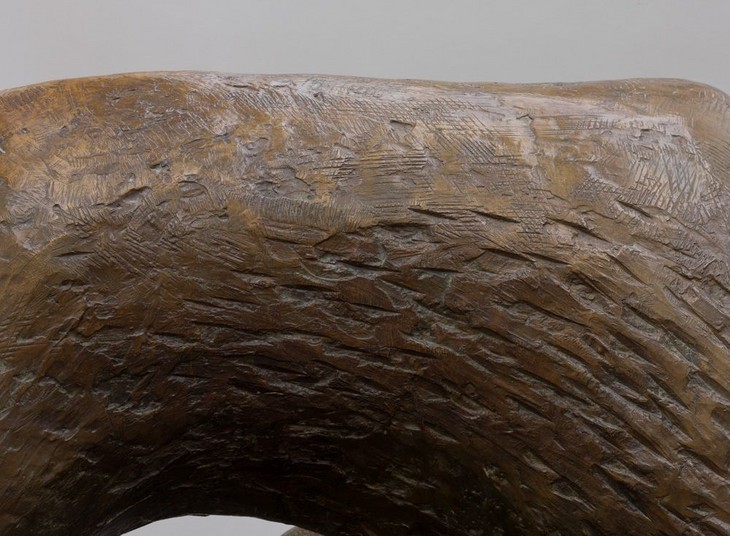
Detail of chisel marks on Working Model for Unesco Reclining Figure 1957, cast c.1959–61
Tate T00390
© The Henry Moore Foundation. All Rights Reserved
Fig.1
Detail of chisel marks on Working Model for Unesco Reclining Figure 1957, cast c.1959–61
Tate T00390
© The Henry Moore Foundation. All Rights Reserved
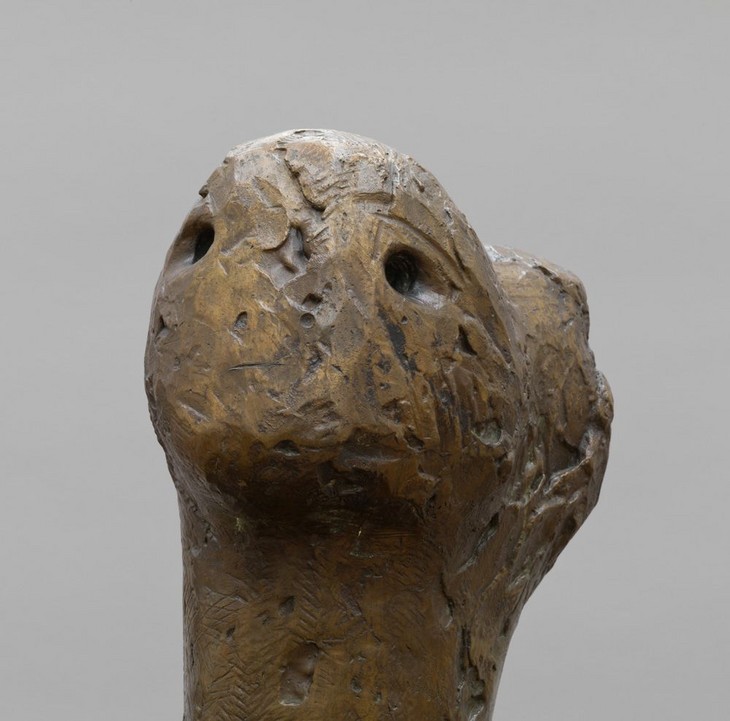
Detail of head of Working Model for Unesco Reclining Figure 1957, cast c.1959–61
Tate T00390
© The Henry Moore Foundation. All Rights Reserved
Fig.2
Detail of head of Working Model for Unesco Reclining Figure 1957, cast c.1959–61
Tate T00390
© The Henry Moore Foundation. All Rights Reserved
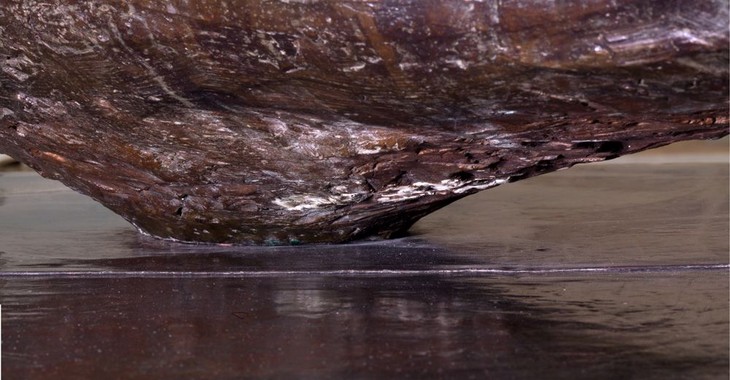
Detail of casting investment on Working Model for Unesco Reclining Figure 1957, cast c.1959–61
Tate T00390
© The Henry Moore Foundation. All Rights Reserved
Fig.3
Detail of casting investment on Working Model for Unesco Reclining Figure 1957, cast c.1959–61
Tate T00390
© The Henry Moore Foundation. All Rights Reserved
Apart from having been chased and cleaned no other post-cast finishing was undertaken on the sculpture. It was artificially patinated by applying various chemical solutions to the bronze, either with or without heat, which reacted with the surface to form various coloured compounds. This sculpture has an even, slightly transparent brown patina with red-brown accents, particularly in the recesses. A light green colour can also be seen in some areas (fig.4). These colours would have been achieved using different chemical solutions, such as potassium polysulphide and ferric nitrate, in varying concentrations. After it had been patinated the sculpture would have been given a coating of wax to protect it.
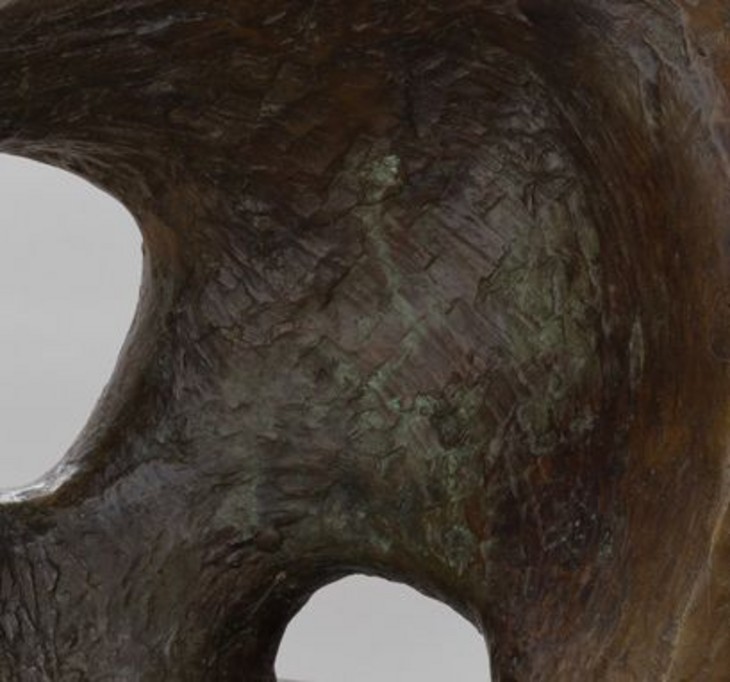
Detail of patina on Working Model for Unesco Reclining Figure 1957, cast c.1959–61
Tate T00390
© The Henry Moore Foundation. All Rights Reserved
Fig.4
Detail of patina on Working Model for Unesco Reclining Figure 1957, cast c.1959–61
Tate T00390
© The Henry Moore Foundation. All Rights Reserved
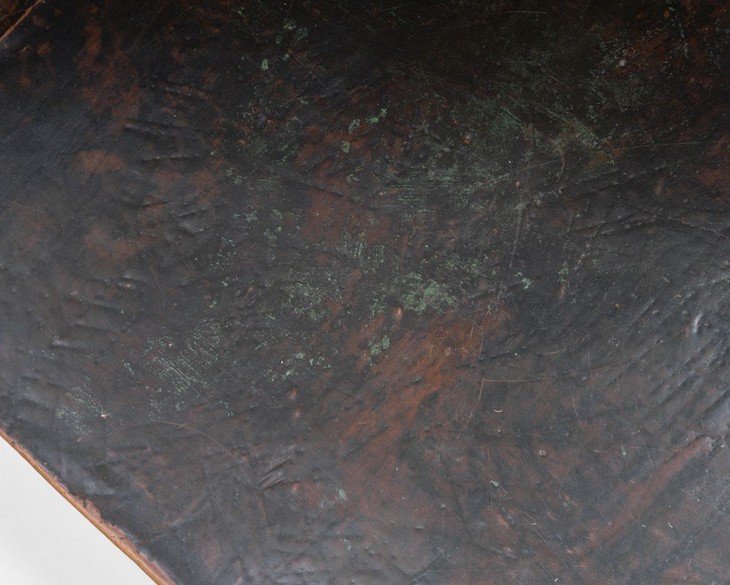
Detail of base of Working Model for Unesco Reclining Figure 1957, cast c.1959–61
Tate T00390
© The Henry Moore Foundation. All Rights Reserved
Fig.5
Detail of base of Working Model for Unesco Reclining Figure 1957, cast c.1959–61
Tate T00390
© The Henry Moore Foundation. All Rights Reserved
The base is made of wood and covered with copper sheets that have been patinated a dark brown colour with some pale green stippling. A seam runs down the centre of the base from end to end revealing where two sheets meet. The top surface of the base is textured with rows of small marks, probably made by lightly hammering a fork or claw chisel into the copper sheet (fig.5). Some edges and central areas of the base have become severely dented, perhaps caused by movements of the sculpture before it was permanently fixed in place. It has not been possible to examine the fixings underneath the base but the sculpture is likely to be attached with bolts at the figure’s left elbow and at various points where the legs and feet meet the base.
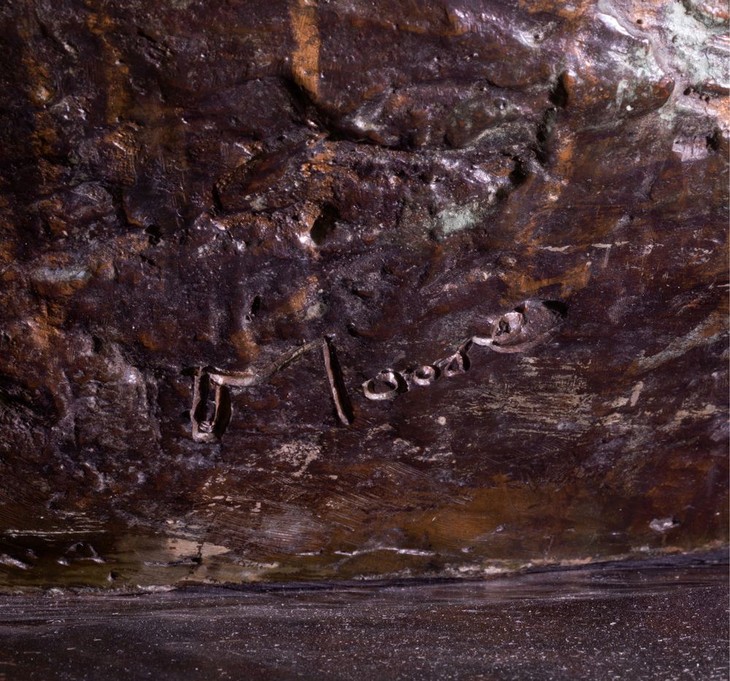
Detail of artist's signature on Working Model for Unesco Reclining Figure 1957, cast c.1959–61
Tate T00390
© The Henry Moore Foundation. All Rights Reserved
Fig.6
Detail of artist's signature on Working Model for Unesco Reclining Figure 1957, cast c.1959–61
Tate T00390
© The Henry Moore Foundation. All Rights Reserved

Detail of foundry stamp on Working Model for Unesco Reclining Figure 1957, cast c.1959–61
Tate T00390
© The Henry Moore Foundation. All Rights Reserved
Fig.7
Detail of foundry stamp on Working Model for Unesco Reclining Figure 1957, cast c.1959–61
Tate T00390
© The Henry Moore Foundation. All Rights Reserved
The sculpture is signed ‘Moore’ and marked ‘II/V’ at the bottom of the figure’s leg (fig.6), and the foundry mark ‘GUSS. H. Noack. Berlin’ can be seen on the feet at the back of the sculpture close to the base (fig.7). A plaque is fixed to the front side of the base to record the fact that it was presented by the Friends of the Tate Gallery in 1960.
Lyndsey Morgan
January 2014
How to cite
Lyndsey Morgan, 'Technique and Condition', January 2014, in Alice Correia, ‘Working Model for Unesco Reclining Figure 1957, cast c.1959–61 by Henry Moore OM, CH’, catalogue entry, December 2013, in Henry Moore: Sculptural Process and Public Identity, Tate Research Publication, 2015, https://wwwEntry
Working Model for Unesco Reclining Figure 1957 is a bronze sculpture of a reclining figure made up of bridge-like forms, holes and arched spaces, which, despite their abstract appearance, have been composed in a way that allows certain features to be recognised as distinct body parts. Indeed, the figure can be seen to be propped up on its left elbow and appears to lie in a twisted position with its legs extending to the side while its bent knees point towards the front. The upright torso and head of the figure face the bulky right leg, which projects up at an angle to the same height as the shoulders, creating a compact horizontal composition (fig.1). The sculpture is mounted on a copper clad wooden base designed by the artist. According to notes held at Tate, the base, which is lightly textured with indentations, ‘has always been regarded as an integral part of the work’.1
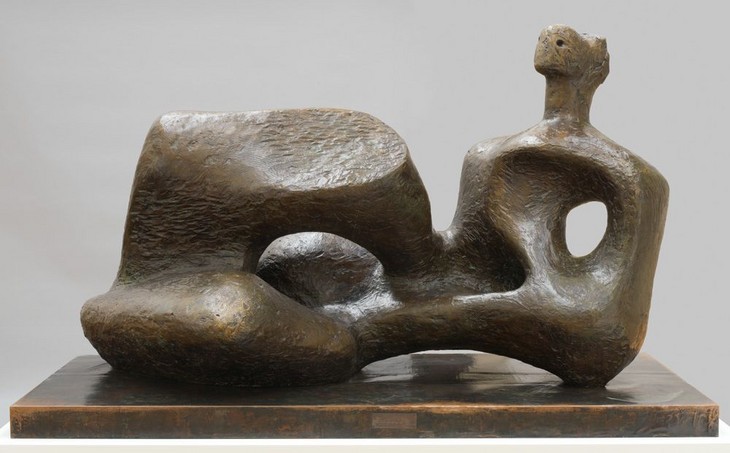
Henry Moore
Working Model for Unesco Reclining Figure 1957, cast c.1959–61
Tate T00390
© The Henry Moore Foundation. All Rights Reserved
Fig.1
Henry Moore
Working Model for Unesco Reclining Figure 1957, cast c.1959–61
Tate T00390
© The Henry Moore Foundation. All Rights Reserved

Detail of head of Working Model for Unesco Reclining Figure 1957, cast c.1959–61
Tate T00390
© The Henry Moore Foundation. All Rights Reserved
Fig.2
Detail of head of Working Model for Unesco Reclining Figure 1957, cast c.1959–61
Tate T00390
© The Henry Moore Foundation. All Rights Reserved
The face of the sculpture has a dappled appearance and features two unevenly positioned eye sockets (fig.2). Two small irregularly shaped circular depressions on the front of the face may be regarded as nostrils, despite the absence of a nose. Underneath these is a very lightly incised line, suggestive of a mouth. The rear of the head has been marked with deep gouges and striations to evoke hair, contrasting with the much smoother neck. In comparison to the rest of the body the head and neck appear disproportionately small, and are notable for the way in which they lean slightly backwards, giving the impression that the figure is looking up and over the ridge formed by the right leg.
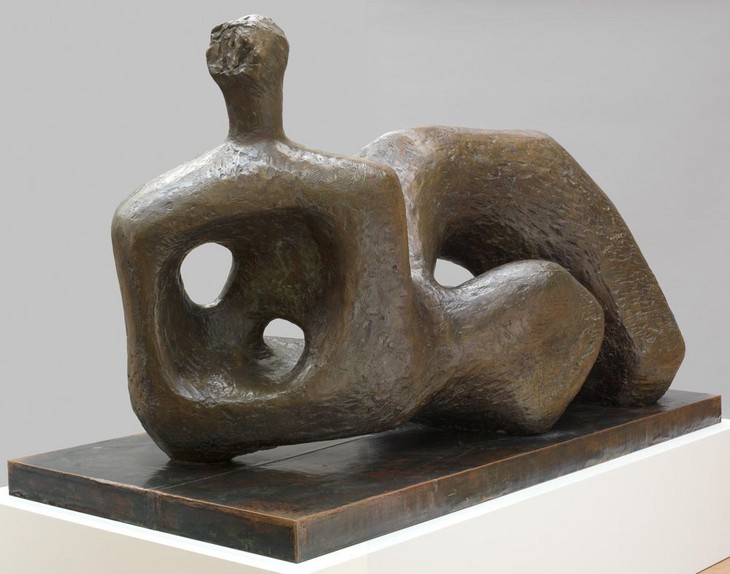
Henry Moore
Working Model for Unesco Reclining Figure 1957, cast c.1959–61 (rear view)
Tate T00390
© The Henry Moore Foundation. All Rights Reserved
Fig.3
Henry Moore
Working Model for Unesco Reclining Figure 1957, cast c.1959–61 (rear view)
Tate T00390
© The Henry Moore Foundation. All Rights Reserved
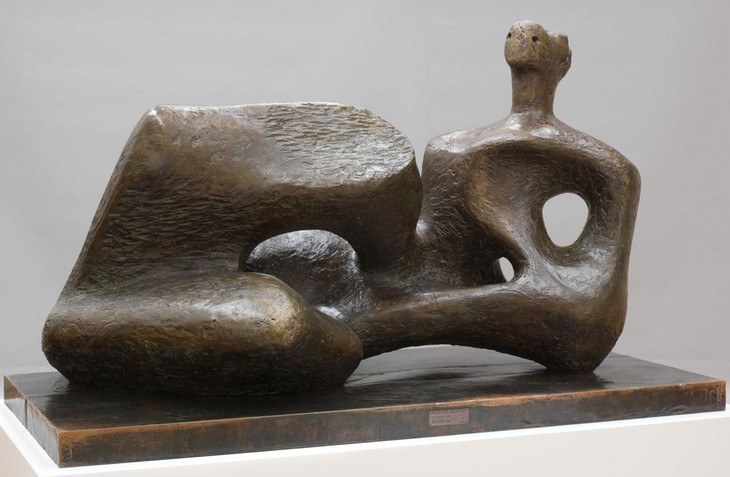
Henry Moore
Working Model for Unesco Reclining Figure 1957, cast c.1959–61
Tate T00390
© The Henry Moore Foundation. All Rights Reserved
Fig.4
Henry Moore
Working Model for Unesco Reclining Figure 1957, cast c.1959–61
Tate T00390
© The Henry Moore Foundation. All Rights Reserved
The roughly square-shaped torso balances on the bulbous left elbow and features two holes, one higher up marking the pit of the left arm and another penetrating the lower abdomen. A large round cavity has been carved into the figure’s back, accentuating its depth, while on the chest a bulky sternum projects forward. From the rear, the body can be seen to extend into a large, anatomically ambiguous, wedge-shaped protrusion that creates a shallow arch over the base (fig.3). The large right leg looms over this form and, from the front, resembles a three-sided arch with an angled upper face. The lower left leg rests horizontally on the front of the base and converges with the downward pointing calf of the right leg (fig.4). A prominent central gap separates the two legs, through which can be seen the large rear form.
The Unesco commission

Henry Moore
Unesco Reclining Figure 1957–8
Travertine marble
Unesco, Paris
© The Henry Moore Foundation. All Rights Reserved
Photo: Henry Moore Foundation Archive
Fig.5
Henry Moore
Unesco Reclining Figure 1957–8
Unesco, Paris
© The Henry Moore Foundation. All Rights Reserved
Photo: Henry Moore Foundation Archive
In 1960 Moore recalled, ‘eventually, after discarding many preliminary studies I decided on a reclining figure that seeks to tell no story at all. I wanted to avoid any kind of allegorical interpretation that is now trite’.5 As early as 1958 the writer W.J. Strachan suggested that the pencil drawings now titled Throne Reclining Figures 1954–7 and Unesco Reclining Figures 1954–7 (fig.6) showed the development of Moore’s design for the reclining figure and formed the basis of a series of clay maquettes.6 The two sketches at the top of Unesco Reclining Figures bear some resemblance to the finished sculpture, despite the fact that in February 1959, in response to a letter from the art collector Alan Wurtzburger, who enquired whether or not there were any preparatory drawings for the Unesco commission available to purchase, Moore wrote, ‘I have looked through my notebooks, but cannot find a drawing which would seem to other people to have any definite connection with the final figure’.7 He continued, ‘The figure came, not so much through any particular drawing, but developed from small models I made in clay’.8 Another sketch titled Drawing for Unesco Reclining Figure 1954–7 (fig.7) also has a remarkable likeness to the final sculpture, but it was not dated by Moore and may have been drawn after the composition of the three-dimensional maquette or working model had already been finalised.
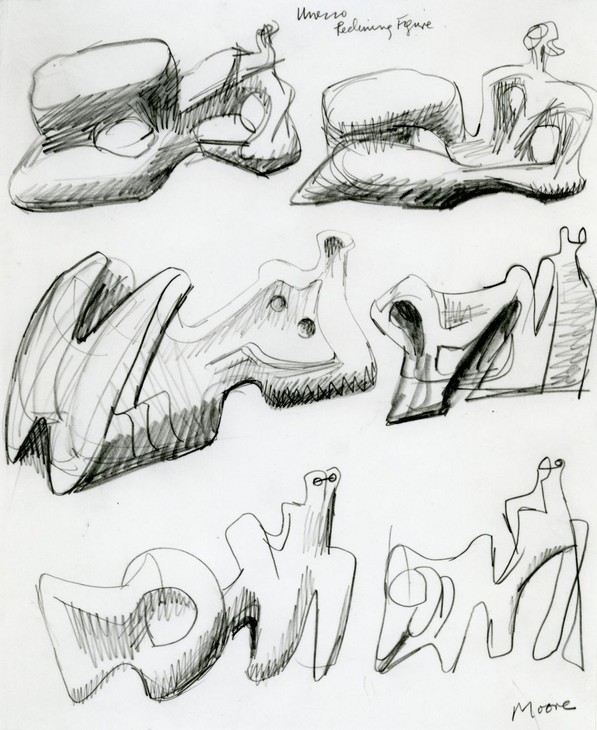
Henry Moore
Unesco Reclining Figures 1954–57
Graphite on paper
292 x 242 mm
Private collection
© The Henry Moore Foundation. All Rights Reserved
Fig.6
Henry Moore
Unesco Reclining Figures 1954–57
Private collection
© The Henry Moore Foundation. All Rights Reserved
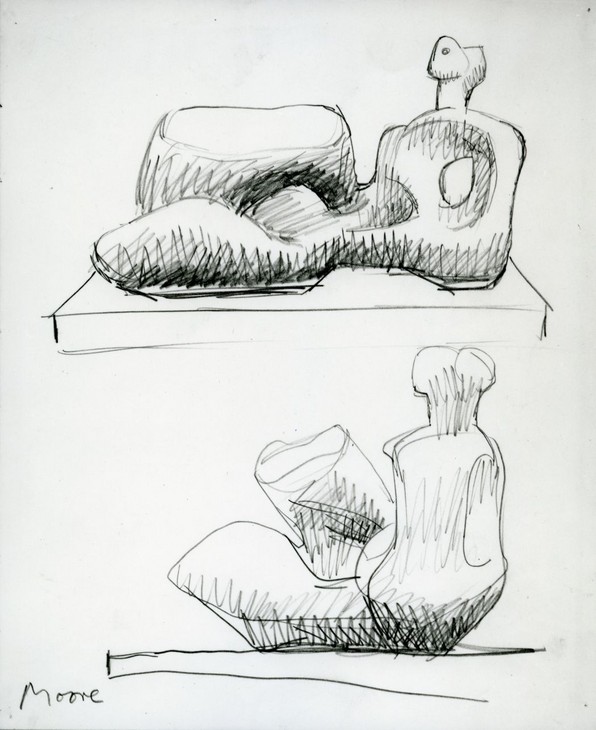
Henry Moore
Drawing for Unesco Reclining Figure 1954–57
© The Henry Moore Foundation. All Rights Reserved
Fig.7
Henry Moore
Drawing for Unesco Reclining Figure 1954–57
© The Henry Moore Foundation. All Rights Reserved
In February 1957 Moore took four maquettes to Paris to be judged by Marcel Breuer, the architect of the new Unesco headquarters, and members of the organisation’s art advisory committee. Every person independently selected the same work, which, as it happens, was also Moore’s favourite (fig.8).9 The panel also accepted Moore’s suggestion to change the material in which the sculpture would be made from bronze to travertine marble. The art historian Margaret Garlake has revealed that ‘after receiving the formal commission in May 1957, Moore completed the half-size working model by early August, more than two years after the initiation of the project’.10 The plaster working model was an enlarged version of the maquette, but smaller than the proposed final sculpture (fig.9). Constructing a working model allowed Moore to refine the composition of his design and consider the arrangement of forms on a larger scale prior to embarking on the full-size work.
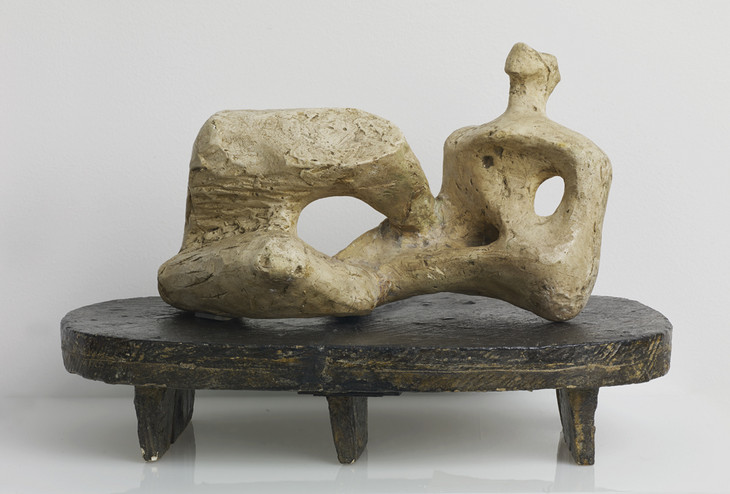
Henry Moore
Maquette for Unesco Reclining Figure 1956
Plaster
Art Gallery of Ontario, Toronto
© The Henry Moore Foundation. All Rights Reserved
Fig.8
Henry Moore
Maquette for Unesco Reclining Figure 1956
Art Gallery of Ontario, Toronto
© The Henry Moore Foundation. All Rights Reserved
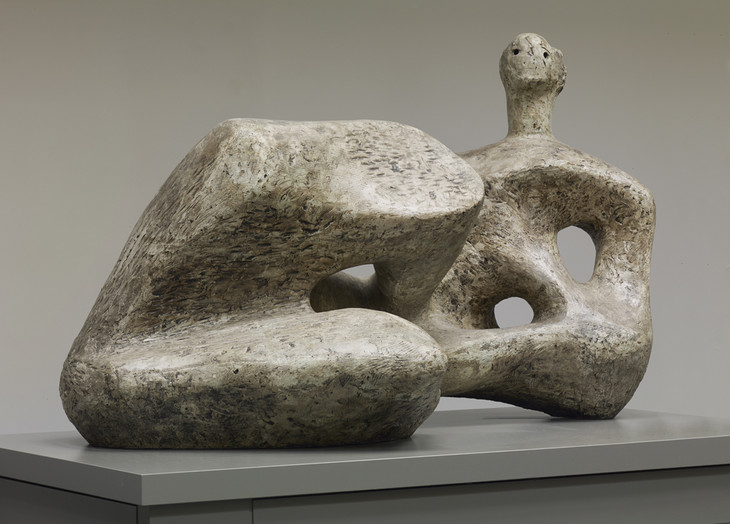
Henry Moore
Working Model for Unesco Reclining Figure 1957
Plaster with surface colour
Art Gallery of Ontario, Toronto
© The Henry Moore Foundation. All Rights Reserved
Fig.9
Henry Moore
Working Model for Unesco Reclining Figure 1957
Art Gallery of Ontario, Toronto
© The Henry Moore Foundation. All Rights Reserved
In order to make the plaster working model Moore and his assistants would first have had to construct an armature for the sculpture to the required size and shape. The armature was probably made from lengths of wood and wire, and then draped or wrapped in layers of scrim, a bandage-like fabric. Layers of plaster were then applied to the armature while its interior remained hollow (fig.10). Moore’s assistants would have completed most of the preliminary work on the working model, including applying successive layers of plaster to the armature and scrim until only a short section of each armature rod was exposed. Moore explained, ‘once they [the assistants] have brought the work within an inch or so of the measurements I intend it to be, I take it over, and then it becomes a thing I’m working on as it would if I had brought it to that stage myself’.11 During this final stage Moore began to work into the surface of the sculpture (fig.11). Using an array of tools different marks and textures could be achieved depending on the wetness of the plaster as it dried. Moore found plaster to be a very useful material because it could be ‘both built up, as in modelling, or cut down, in the way you carve stone or wood’.12 According to Strachan, the head of Working Model for Unesco Reclining Figure ‘with its slight upward tilt, symbolically as well as plastically so effective, is the climax of the conception ... Moore took immense pains over the placing of the eye socket. Formalized as usual but by no means arbitrarily, their depth and expression set the mood of the whole’.13 In 1965 Read also noted that ‘the head has an air of alert expectancy, of intelligent curiosity’.14
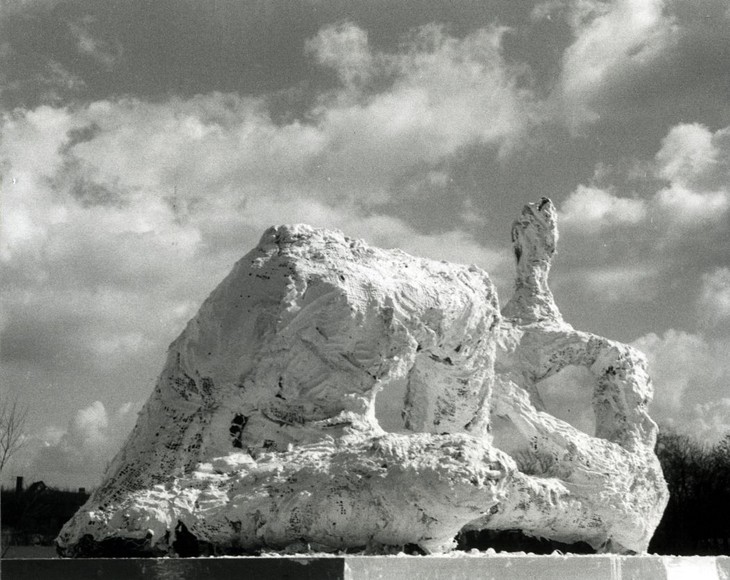
Working Model for Unesco Reclining Figure 1957, plaster in progress
© The Henry Moore Foundation. All Rights Reserved
Fig.10
Working Model for Unesco Reclining Figure 1957, plaster in progress
© The Henry Moore Foundation. All Rights Reserved
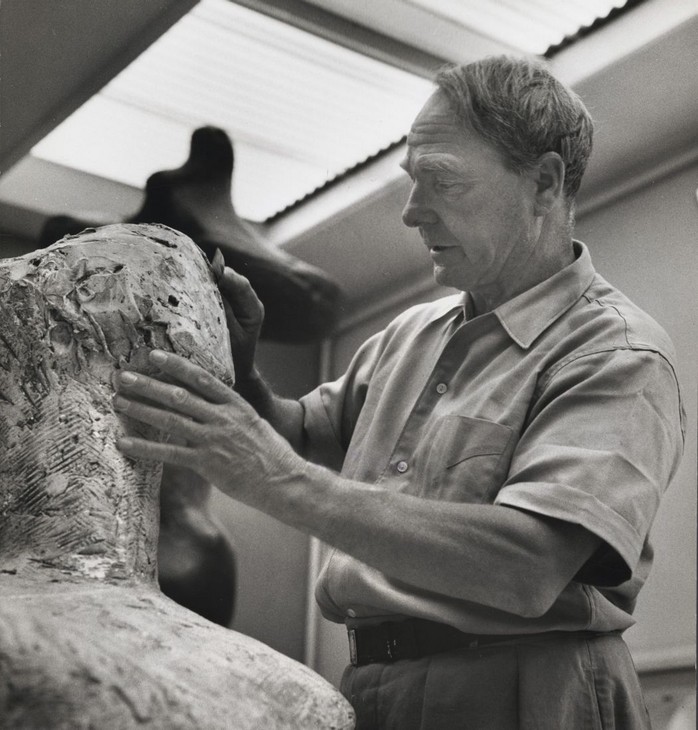
Henry Moore working on plaster Working Model for Unesco Reclining Figure 1957
© The Henry Moore Foundation. All Rights Reserved
Fig.11
Henry Moore working on plaster Working Model for Unesco Reclining Figure 1957
© The Henry Moore Foundation. All Rights Reserved
In September 1957 a plaster working model for the Unesco sculpture arrived at the Société S. Henraux quarry at Querceta in Italy, where the full-size marble sculpture was carved.15 Using the working model as a template, the artisans at Henraux measured and scaled up the sculpture and roughed out its shape from four large blocks of stone. Moore made regular trips to Italy to oversee the carving, which was completed in the summer of 1958. Unesco Reclining Figure, weighing a total of thirty-eight tons and over sixteen feet long and eight feet high, was installed in Paris in October 1958 ready for the inauguration of the Unesco building in November.
From plaster to bronze
It seems that Moore was initially uncertain about casting the working model in bronze. On 2 January 1959, in a letter to Andrew Ritchie, Director of the Albright-Knox Art Gallery in Buffalo, Moore reported:
When I first began this sculpture, nearly two years ago, it was a bigger figure than any I had previously done, and I wasn’t to know if anyone would want such a large bronze, and so when Charles Gimpel asked me, while it was still unfinished, to reserve a cast for him, I was quite pleased and promised I would.16
Charles Gimpel was the director of the London-based commercial gallery Gimpel Fils, and it is likely that he sold the reserved cast of Working Model for Unesco Reclining Figure to the American collector Arnold Maremont. Although Gimpel did not formally represent Moore, the two men were close friends and Moore would often reserve sculptures for Gimpel’s clients. Seven bronze casts of Working Model for Unesco Reclining Figure were ultimately made over a four-year period, but they were not all cast at the same foundry: three casts were produced by Corinthian Art Bronze Foundry in London, two by Susse Fondeurs in Paris, and two at the Noack Foundry in West Berlin.
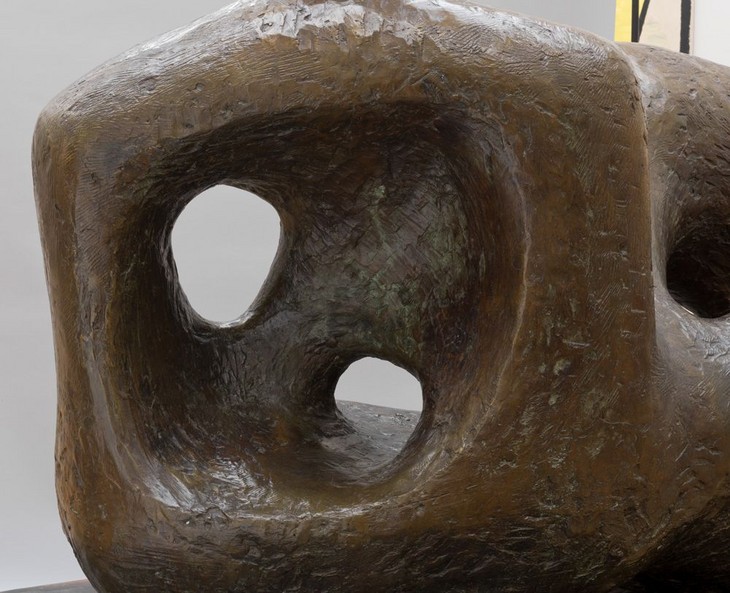
Detail of patina on Working Model for Unesco Reclining Figure 1957, cast c.1959–61
Tate T00390
© The Henry Moore Foundation. All Rights Reserved
Fig.12
Detail of patina on Working Model for Unesco Reclining Figure 1957, cast c.1959–61
Tate T00390
© The Henry Moore Foundation. All Rights Reserved
Contexts and interpretations
In 1958 Strachan noted that the design of the Unesco figure related closely to specific examples of Moore’s earlier work. The bent and slightly parted legs of Reclining Figure 1929 (fig.13), which extend to the side of an upright head and shoulders, seem to prefigure the pose and angles of the Unesco sculpture. Another Reclining Figure, carved in elm in 1935–6 (fig.14), relates more directly to the composition of Working Model for Unesco Reclining Figure, and features a hole through the figure’s torso, which serves to open out the sculpture. In 1937 Moore articulated his appreciation of holes in an article published in the Listener magazine:
Pebbles show nature’s way of working stone. Some of the pebbles I pick up have holes right through them ... A piece of stone can have a hole though it and not be weakened – if the hole is of a studied size, shape and direction. On the principle of the arch, it can remain just as strong. The first hole made through a piece of stone is a revelation. The hole connects one side to another, making it immediately more three-dimensional. A hole can have as much shape-meaning as a solid mass. Sculpture in air is possible, where the stone contains only the hole, which is the intended and considered form. The mystery of the hole – the mysterious fascination of caves in hillsides and cliffs.18
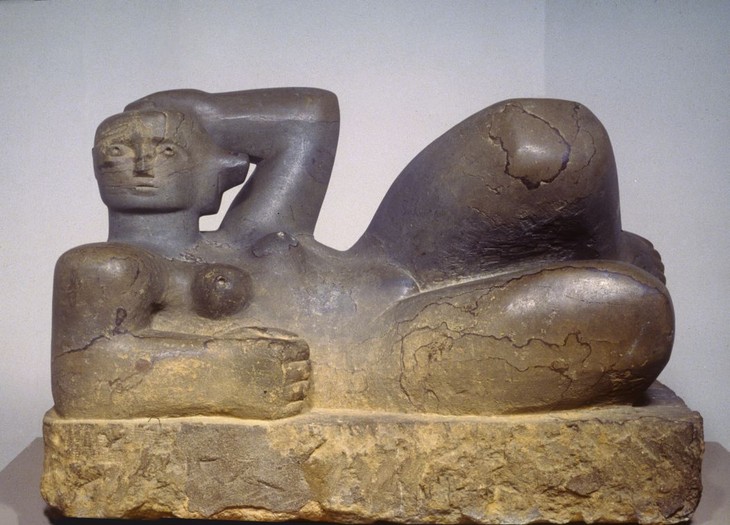
Henry Moore
Reclining Figure 1929
Brown Hornton stone
Leeds City Art Gallery
© The Henry Moore Foundation. All Rights Reserved
Fig.13
Henry Moore
Reclining Figure 1929
Leeds City Art Gallery
© The Henry Moore Foundation. All Rights Reserved
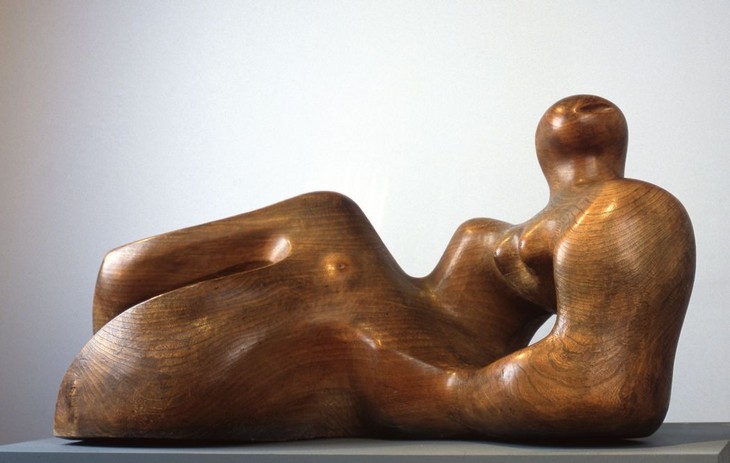
Henry Moore
Reclining Figure 1935–6
Elm
Albright-Knox Gallery, Buffalo
© The Henry Moore Foundation. All Rights Reserved
Fig.14
Henry Moore
Reclining Figure 1935–6
Albright-Knox Gallery, Buffalo
© The Henry Moore Foundation. All Rights Reserved
The close formal relationships between Moore’s work of the 1930s and the much later Working Model for Unesco Reclining Figure are indicative of Moore’s abiding interest in natural forms and processes. Discussing Moore’s Unesco sculpture, the art historian Christa Lichtenstern argued in 2008 that ‘with the natural rhythms of its vibrant forms, this reclining figure epitomises Moore’s view of civilisation as an “organic process”’.19
In his 1959 analysis of Moore’s work the psychologist Erich Neumann argued that the artist’s post-war female figures should be viewed as examples of the archetypal ‘Great Mother’.20 Identifying the centrality of this archetype to ancient civilisations, Neumann described the Great Mother as a symbol of ‘nourishment, shelter and security’, and ‘the mistress of life and fertility’.21 He argued that:
the artist’s fascination with the mother archetype is, however, by no means only a personal phenomenon of his individual history; it represents an advance into a psychic realm that is of fateful importance not only for himself but for his whole age, if not for mankind in general ... In an age when Western man, through his exaggerated respect for the patriarchal spirit and the techniques it has engendered, is in danger of losing contact with the roots of existence, there has arisen in the unconscious, in accordance with a general psychic law, a compensatory tendency that is reactivating this feminine, maternal earth-nature aspect, which has been too much repressed.22
Although Neumann did not specifically mention the Unesco sculptures in his book, Herbert Read drew heavily on this interpretation in his own discussion of the full-size Unesco Reclining Figure published in 1965, quoting Neumann’s assertion that ‘the birth of the feminine archetype in modern man signifies at the same time the development of human relatedness, of his social capacity and the growing consciousness of the unity of mankind on earth’.23 Read went on to state that ‘if this is a true interpretation of Moore’s work, and I believe it is, then what could be more appropriate as a symbol of the aims of UNESCO than this figure, the feminine earth archetype, the mother of life itself?’.24
In 2001 the art historian Christopher Pearson considered Moore’s Unesco Reclining Figure in light of the ideology of post-war internationalism that led to the formation of the United Nations and Unesco. Pearson acknowledged that ‘it is increasingly difficult to sense the fierce optimism that shaped’ the buildings and the artworks commissioned by these organisations, which, over time, became ‘austere symbols of a new age of technological progress and international co-operation’.25 For Pearson, by taking a ‘non-narrative’ approach to his commission, Moore successfully embodied the ‘vague idealism’ of Unesco by creating a sculpture that had an ‘iconographic opacity – a vision too subjective to be fully transmissable’.26 Indeed, as Pearson noted, after the sculpture’s unveiling critics were wary of articulating its symbolic meaning or allegorical message; writing in the Architectural Record J.E. Burchard simply stated that Moore’s sculpture had ‘a symbolism that has something to do with what UNESCO stands for’.27 Overall, however, the critical and public reaction to Moore’s Unesco sculpture was hostile, finding it either too modern or not contemporary enough.28 Pearson concluded that Moore’s sculpture, Breuer’s building, and indeed Unesco itself should be regarded as ‘nostalgic reminders of a better world that never arrived’.29
Henry Moore and the Tate collection
Tate held thirteen sculptures by Henry Moore in its collection prior to the acquisition of Working Model for Unesco Reclining Figure in 1960. Since a large number of these were small maquettes, by the late 1950s the Trustees of the Tate were keen to expand the gallery’s holdings of Moore’s work. Acquisitions of Moore’s work had been hindered since the 1930s, first by J.B. Manson, Tate’s director between 1930 and 1938, who disliked modern art and who told Tate trustee Robert Sainsbury ‘Over my dead body will Henry Moore ever enter the Tate’,30 and then by Moore’s subsequent post as a trustee of the gallery from 1941–8 and then 1949–56.31
After stepping down from his role as a trustee, Moore discussed a number of sculptures that could be made available to Tate with the gallery’s director, Sir John Rothenstein. Moore proposed a list of eight works, which was presented to the trustees at their meeting on 16 May 1957.32 This coincided with Moore beginning work on Working Model for Unesco Reclining Figure, which, according to Moore, Rothenstein expressed an interest in acquiring for Tate.33 Two years later, and after the successful showing of one of the bronze casts in London, Tate confirmed their interest and enquired whether it would be possible to have another cast made, since all the other casts in the edition had already been sold. On 16 June 1959 Moore wrote to his patron Alan Wurtzbrger, who had arranged the Baltimore Museum of Art’s acquisition of Working Model for Unesco Reclining Figure in 1959, explaining:
This situation happened previously with my KING AND QUEEN [1952–3, Tate T00228]. The Tate again were late on the scene, and in that case, I wrote to the owners explaining the situation and telling them that a work once acquired by the Tate cannot be sold again, and so there would be no possibility of it ever coming on to the market. Also, being in the Tate Gallery would help, if anything, to raise the value of the other casts. All the owners willing agreed to allow me to make an extra cast which the Tate acquired for the cost of the casting, (plus my patinating expenses and transport on it). Now I feel pretty certain the UNESCO figure is about the most important and most representative work I have done in recent years, and naturally, if it’s possible, I would like the Tate Gallery to have a cast of this

Detail of edition number on Working Model for Unesco Reclining Figure 1957, cast c.1959–61
Tate T00390
© The Henry Moore Foundation. All Rights Reserved
Fig.15
Detail of edition number on Working Model for Unesco Reclining Figure 1957, cast c.1959–61
Tate T00390
© The Henry Moore Foundation. All Rights Reserved
A letter to Moore dated 1 June 1961 from Jane Lascelles, Organising Secretary for the Friends, notes that there was no correspondence about the acquisition of these sculptures in the Friends’ files, suggesting that the particulars of the sale, including prices, were agreed verbally with Moore.37 In addition to Working Model for Unesco Reclining Figure, the other sculptures presented to the gallery in December 1960 were Composition 1932 (Tate T00385), Stringed Figure 1938, cast 1960 (Tate T00386), Reclining Figure 1939, cast 1959 (Tate T00387), Helmet Head No.1 1950, cast 1960 (Tate T00388) and Mother and Child 1953, cast c.1954 (T00389).
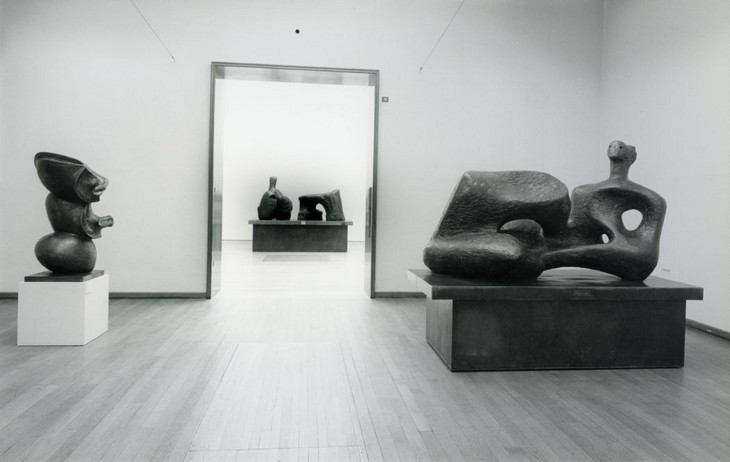
Installation view of The Henry Moore Gift, Tate Gallery, London 1978
Tate Archive
© The Henry Moore Foundation. All Rights Reserved
Fig.16
Installation view of The Henry Moore Gift, Tate Gallery, London 1978
Tate Archive
© The Henry Moore Foundation. All Rights Reserved
Working Model for Unesco Reclining Figure is numbered 415 in Moore’s catalogue raisonné and exists in an edition of seven, although only five plus an artist’s cast had initially been intended.39 Other examples are held in the collections of the Carnegie Museum of Art, Pittsburgh; Chicago Art Institute, Chicago; Kunsthaus, Zürich; and Stedelijk Museum, Amsterdam. Although a cast is listed as belonging to the Baltimore Museum of Art in the artist’s catalogue raisonné, the location of this cast cannot be verified.
Alice Correia
December 2013
Notes
Alexander Dunluce, memo to the Director, 5 July 1990, Tate Conservation File, Henry Moore, T00390.
It is not surprising that Moore was selected for the commission. The building was being designed by Marcel Breuer, who Moore had known since the 1930s when they both lived in Hampstead, and Moore’s long-time supporter, the art critic Herbert Read, was a member of the committee advising on art commissions. Unesco’s first Director General, Julian Huxley, was also a close friend of Moore’s. In August 1956 Moore wrote to Read: ‘It’s not going to be an easy commission. So far what ideas have come (some of them) might work out as sculpture purely for myself, but no one idea has turned up to concentrate on yet ... I have given up all my other work ... [but] the size and importance of the commission is such that I can’t expect even the preliminary stages to be quick.’ Henry Moore, letter to Herbert Read, 7 August 1956, cited in Roger Berthoud, The Life of Henry Moore, 1987, 2nd edn, London 2003, pp.305–6.
Henry Moore, letter to A. Manuelides, 25 September 1956, Henry Moore Foundation Archive, cited in Margaret Garlake, ‘Moore’s Eclecticism: Difference, Aesthetic Identity and Community in the Architectural Commissions 1938–58’, in Jane Beckett and Fiona Russell (eds.), Henry Moore: Critical Essays, Aldershot 2003, p.188.
Herbert Read, ‘Introduction’, in Alan Bowness (ed.), Henry Moore. Volume 3: Sculpture and Drawings 1955–64, 1965, revised edn, London 1986, p.6.
Henry Moore cited in Edouard Roditi, Dialogues on Art, London 1960, pp.179–88, reprinted in Alan Wilkinson (ed.), Henry Moore: Writings and Conversations, Aldershot 2002, p.286.
See W.J. Strachan, ‘Henry Moore’s UNESCO Statue’, Studio, vol.156, no.789, December 1958, p.171. For another of Moore’s preparatory drawings for the Unesco commission see http://www.britishmuseum.org/research/collection_online/collection_object_details.aspx?objectId=733178&partId=1&searchText=henry+moore&page=1 , accessed 18 December 2013.
Henry Moore cited in Donald Hall, ‘Henry Moore: An Interview by Donald Hall’, Horizon, November 1960, reprinted in Wilkinson 2002, p.226.
Strachan 1958, p.173. It is not known whether this was the hand-made plaster sculpture or a plaster cast of it.
For a video explaining the lost wax process, see http://www.vam.ac.uk/content/articles/s/sculpture-techniques/ , accessed 23 January 2014.
Henry Moore, ‘A Sculptor Speaks’, Listener, 18 August 1937, pp.338–40, reprinted in Wilkinson 2002, p.195.
Christopher Pearson, ‘Hepworth, Moore and the United Nations: Modern Art and the Ideology of Post-War Internationalism’, Sculpture Journal, no.6, 2001, p.89.
J.E. Burchard, ‘Unesco House Appraised’, Architectural Record, no.127, May 1960, p.155, cited in ibid., p.95.
Minutes of Meeting of the Trustees of the Tate Gallery, 16 May 1957, Tate Public Records TG 4/2/742/2.
Related essays
- Henry Moore and ‘Sculpture in the Open Air’: Exhibitions in London’s Parks Jennifer Powell
- Scale at Any Size: Henry Moore and Scaling Up Rachel Wells
- Henry Moore and Direct Carving: Technique, Concept, Context Sarah Victoria Turner
- Fashioning a Post-War Reputation: Henry Moore as a Civic Sculptor c.1943–58 Andrew Stephenson
- Circling Each Other: Henry Moore and Adrian Stokes Richard Read
- At the Heart of the Establishment: Henry Moore as Trustee Julia Kelly
- Erich Neumann on Henry Moore: Public Sculpture and the Collective Unconscious Tim Martin
Related catalogue entries
Related material
-
Photograph
Related reviews and articles
- Henry Moore, ‘The Sculptor in Modern Society’ Unesco, International Conference of Artists, Venice 1952.
How to cite
Alice Correia, ‘Working Model for Unesco Reclining Figure 1957, cast c.1959–61 by Henry Moore OM, CH’, catalogue entry, December 2013, in Henry Moore: Sculptural Process and Public Identity, Tate Research Publication, 2015, https://www

